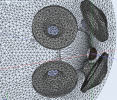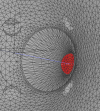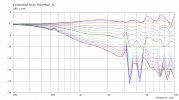AwesomeSauce2015
Active Member
- Joined
- Apr 14, 2022
- Messages
- 248
- Likes
- 254
Howdy everyone!
I am toying with the idea of a very compact unity horn (12"x12"x15" ideally).
The goal being to have point-source behavior as well as high output, but without the gigantic size and cost of comparable systems (ie: Danley SH50) or the downsides of pro audio coax drivers (rough FR).
I understand that without the large size, we lose pattern control at a higher frequency, but I still think that constant directivity from around 1khz up is still pretty nice.
So my question is this: Am I crazy? Could this possibly work? And if so, how would I go about simulating this?
I've looked on here and it seems like AKABAK is one place to start for simulating things, but is there anything else I should know about?
Thanks!
I am toying with the idea of a very compact unity horn (12"x12"x15" ideally).
The goal being to have point-source behavior as well as high output, but without the gigantic size and cost of comparable systems (ie: Danley SH50) or the downsides of pro audio coax drivers (rough FR).
I understand that without the large size, we lose pattern control at a higher frequency, but I still think that constant directivity from around 1khz up is still pretty nice.
So my question is this: Am I crazy? Could this possibly work? And if so, how would I go about simulating this?
I've looked on here and it seems like AKABAK is one place to start for simulating things, but is there anything else I should know about?
Thanks!



